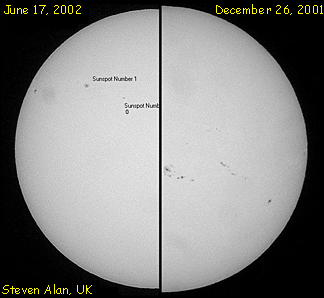When is earth closest to the Sun?
![]()
On January 4, 2003, our Earth made its closest approach to the Sun for the year-- an event astronomers call perihelion. At perihelion, the Earth is about 147.5 million km away from the Sun. (At the greatest separation, the two are about 152.6 million km apart - which will occur this year on July 4.) Relatively speaking, Earth's distance from the Sun doesn't change all that much throughout the year, nevertheless there are measurable differences in solar heating that result from our planet's slightly elliptical orbit.
Averaged over the globe, sunlight falling on Earth in January is about 7% more intense than it is in July. However, the northern hemisphere of Earth has more land, while the southern hemisphere has more water and that tends to lessen the impact of differences in sunlight between the closest approach and the greatest distance. Sunlight raises the temperature of land more than it does oceans. In July (at aphelion), the land-rich northern half of our planet is tilted toward the Sun. Aphelion sunlight is a little weaker than sunlight at other times of the year, but it nevertheless does a good job warming the continents. In fact, say climate scientists, northern summer in July when the Sun is more distant than usual is a bit warmer than the southern hemisphere summer when the Earth is closer to the Sun.
 |
|
| In the image above taken by Steven Alan in the United Kingdom near the times of the greatest and least separation between the Earth and Sun, it is clear the Sun is slightly larger in December due to the lesser distance. |
So if it is not the varying distance between the Earth and Sun which causes seasons, what is it? Seasonal weather patterns are mostly caused by the 23.5-degree tilt of our planet's spin axis and not by Earth's elliptical orbit. During northern winter, the north pole is tilted away from the Sun. Days are short and that makes it cold. The fact that we're a little closer to the Sun in January doesn't make much difference.
NOTE: Seasons are reversed in the southern hemisphere. When the north pole is tilted away from the Sun, as it is now, the south pole is tilted toward it. As a result, summer is currently in full swing south of the equator!
![]()
The StarChild site is a service of the High Energy Astrophysics Science Archive Research Center (HEASARC), within the Astrophysics Science Division (ASD) at NASA/ GSFC.
StarChild Authors: The StarChild Team
StarChild Graphics & Music: Acknowledgments
StarChild Project Leader: Dr. Laura A.
Whitlock
Curator:
Responsible NASA Official: